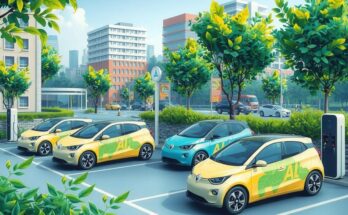Kenya is witnessing a notable increase in electric vehicle and motorcycle adoption, reflecting a global upward trend where EV sales rose by 25% in 2024. The International Energy Agency (IEA) reports overall global EV sales exceeded 17 million units, driven largely by China. In Kenya, energy consumption in the electric mobility sector surged by 466%. However, e-mobility still represents a minor percentage of the country’s total energy consumption.
Kenya is experiencing a significant rise in the adoption of electric vehicles (EVs) and motorcycles, reflecting a global trend towards e-mobility. This surge is driven by climate action initiatives, with the International Energy Agency (IEA) reporting a 25% increase in global EV sales in 2024, reaching over 17 million units, compared to fewer than 14 million the previous year.
The IEA highlighted that “Electric car sales continued to rise globally in 2024, increasing by more than 25% to over 17 million units.” During this period, EV sales represented over 20% of total car sales globally. China remains the dominant force in this sector, accounting for nearly two-thirds of global EV sales, with its market growing nearly 40% annually. In addition, other emerging markets and developing economies outside of China witnessed an impressive 80% increase in EV sales.
In Kenya, the Energy and Petroleum Regulatory Authority (EPRA) noted a remarkable 466% increase in energy consumption in the electric mobility sector in the last six months of 2024, where consumption grew from 0.32 GWh to 1.81 GWh. Nevertheless, e-mobility constituted only 0.03% of Kenya’s total energy consumption.
EPRA’s report further illustrated that industrial consumers constitute the largest segment of electricity users in Kenya, consuming 2,807.10 GWh, which is 51.18% of total consumption, reflecting a 101 GWh increase from the previous year. Domestic consumers followed, utilizing 1,728.19 GWh, an increase from 1,599.33 GWh in the prior year and representing 31.51% of the total energy consumption.
Small commercial enterprises registered a usage of 902.94 GWh, which is about 16.46% of total consumption, an increase from 843.04 GWh year-on-year. In contrast, street lighting consumption saw a decline, dropping to 44.48 GWh from 56.48 GWh in the preceding financial year, accounting for about 0.81% of total energy consumption as indicated by EPRA.
In summary, Kenya is aligning with the global move towards electric mobility, evidenced by a significant increase in EV and motorcycle adoption. The global surge in electric vehicle sales, particularly in markets such as China, influences Kenya’s evolving sector, with substantial energy consumption growth noted in its electric mobility category. However, it remains a small fraction of overall energy usage, highlighting the potential for further development in Kenya’s e-mobility landscape.
Original Source: eastleighvoice.co.ke




